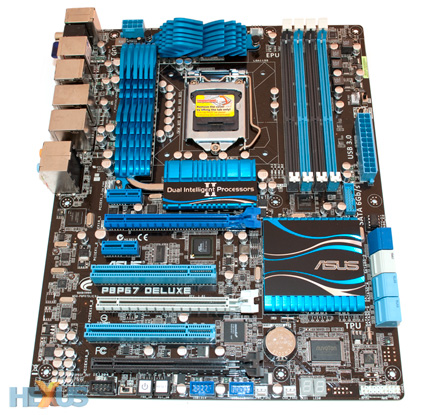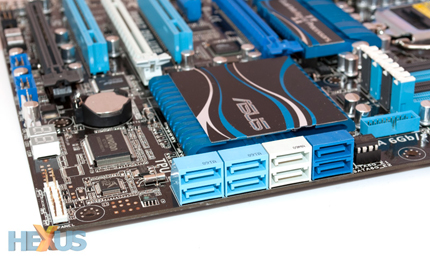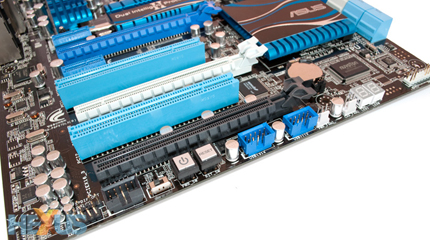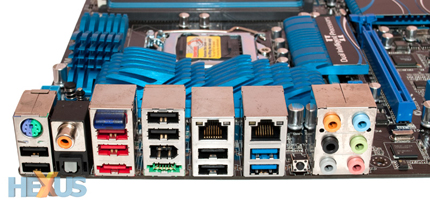Introduction
Been left impressed with Intel's brand spankin' new Sandy Bridge processors? We were, and we've since been eyeing up a couple of supporting P67 motherboards to see which best meets the needs of your next mid-to-high-end build.
Having already examined Gigabyte's £100 GA-P67A-UD3, we're now turning our attention to something a little more up-market; ASUS's £170 P8P67 Deluxe.
Launched as one of the Taiwanese manufacturer's nine available P67 models, the P8P67 Deluxe touts high-end features at a sub-£200 price point. Based on Intel's P67 chipset, the board supports your choice of LGA1155 processors across the Core i3, Core i5 and Core i7 product lines and targets users who are planning on employing a third-party graphics solution. Remember, outputting visuals from Sandy Bridge's integrated GPU is currently limited to the more basic H67 platform.
Finished in a cool black-and-blue colour scheme, ASUS's board is visually pleasant and makes full use of the 30.5cm x 24.4cm ATX form factor. Living up to its high-end ambition, the P8P67 provides a healthy array of expansion slots - including three PCIe x16 slots, two PCIe x1 slots and a pair of standard PCI slots, too.
Both AMD CrossFire and NVIDIA SLI are supported, but bandwidth does take a knock in multi-GPU configurations. Intel's Sandy Bridge CPU provides 16 lanes to play with and ASUS integrates a PLX bridge chip to accumulate an additional eight. In terms of GPU capabilities, the total 24 lanes facilitate a choice of configurations across the three full-size PCIe slots; single x16, dual x8, or a three-way x8, x8, x4 setup. There's ample room between expansion slots for dual-width cards, and the board - despite its agglomeration of features - feels roomy throughout.
The LGA1155 CPU socket - which remember isn't backward compatible with LGA1156 processors - is served by an enthusiast-orientated 16+2 phase power design and an array of heatpipe-connected, low-profile aluminium heatsinks. There's plenty of room for most air coolers, and the four dual-channel DDR3 DIMM slots sit a comfortable distance away from the CPU socket. A whopping 32GB of memory is supported at speeds of up to 2,133MHz, matching what's on offer from last-generation LGA1156 boards.
As you'd expect from a high-end board, cooling is well catered for and ASUS provides a four-pin CPU fan header, a four-pin chassis fan header and a further three three-pin headers.
Piling on the features, the board sports a MemOK! button as well as dedicated hardware switches for ASUS's exclusive "Dual Intelligent Processors", EPU (Energy Processing Unit) and TPU (TurboV Processing Unit). The former keeps an eye on CPU load to dynamically regulate system power for an "optimal energy-saving configuration", while the latter provides one-click automatic overclocking functionality. More on that later.
Along the bottom right edge, ASUS expands on P67's standard six SATA connectors - two SATA 6Gbps (white) and four SATA 3Gbps (light blue) - by adding a further two high-speed SATA 6Gbps ports (dark blue) courtesy of an onboard Marvell 9128 controller. To the right of the angled SATA ports lies a removable UEFI BIOS chip and a 19-pin header for the bundled front-panel USB 3.0 box.
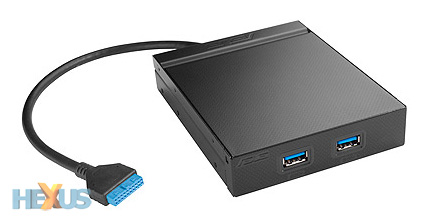
The 3.5in unit will fit most chassis and despite looking a little sparse with only two ports, it's a handy means of bringing SuperSpeed USB 3.0 to the front of existing enclosures. Intel is showing little desire to adopt USB 3.0 in its chipsets, so the P8P67D makes use of two NEC controllers - one for the breakout box pictured above, and the other for the two USB 3.0 ports on the board's rear I/O panel.
To the bottom of the board, ASUS provides a handful of features usually reserved for enthusiast users; namely dedicated power and reset buttons, and debug LEDs for displaying post error codes. The same edge houses a pair of USB 2.0 headers, an IEEE 1394 header and connectors for front-panel audio.
Continuing the trend thus far, the rear I/O panel doesn't skimp on connectivity options. The P8P67D I/O provides a total of 10 USB ports (eight USB 2.0 and two USB 3.0), two eSATA ports (one of which is powered), FireWire, a combination PS/2 keyboard/mouse connector, a Bluetooth module, a dedicated clear CMOS button and dual Gigabit Ethernet jacks - one fed by a Realtek 8111E LAN controller, the other by Intel's 82579 controller.
The onboard Realtek ALC889 high-def audio codec, meanwhile, can output via eight-channel analogue connectors, or either coaxial or optical S/PDIF. There's no built-in Wi-Fi, but it's an otherwise excellent selection of ports and connectivity options.
Few P67 boards are as feature packed as this, but do the hardware additions warrant the near-£200 outlay? Let's see what the P8P67D is like in use.






